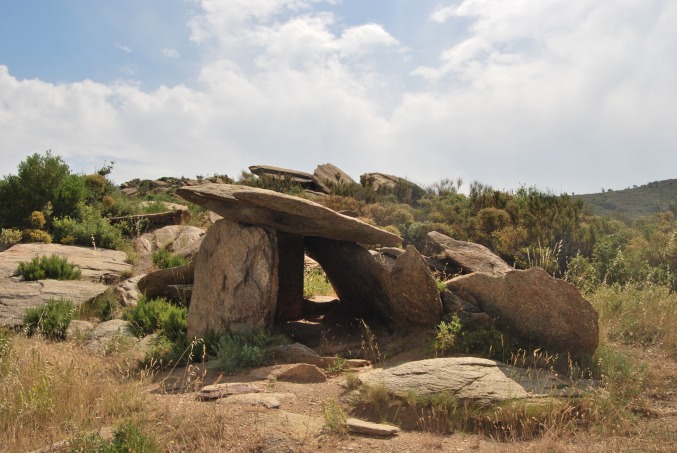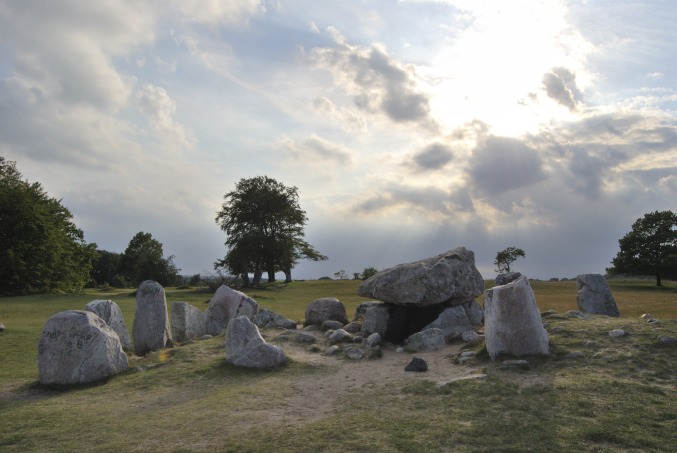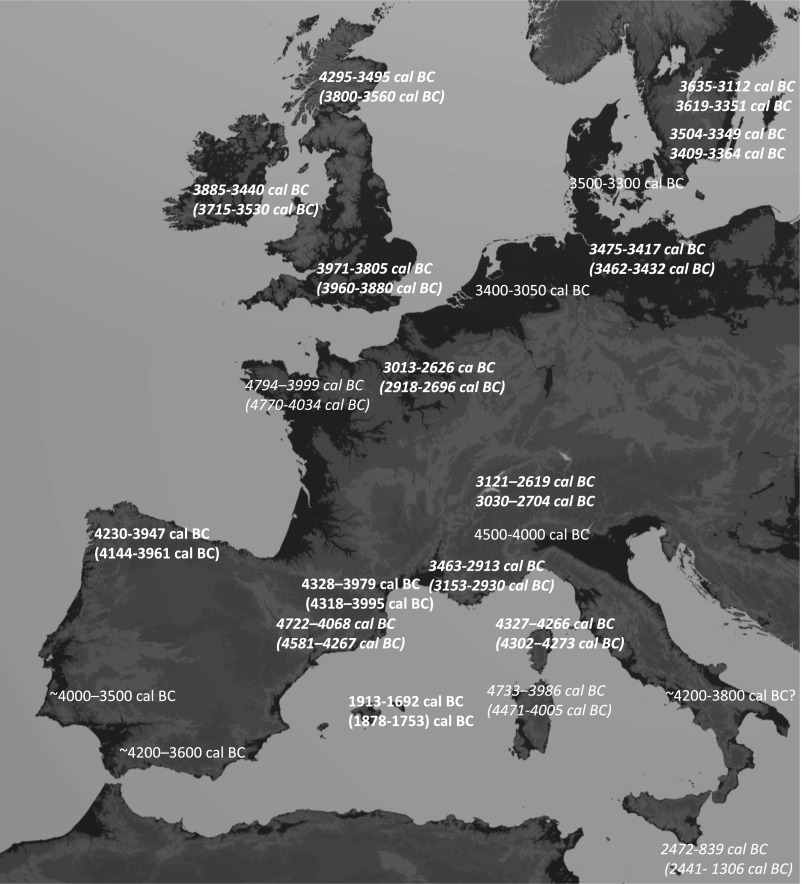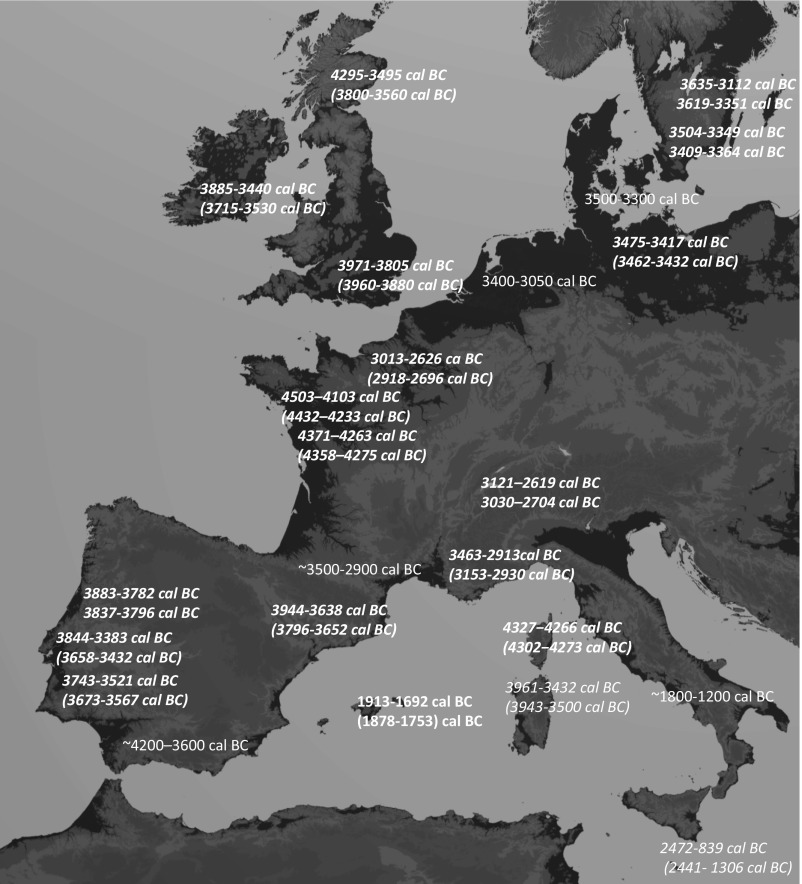Radiocarbon dates and Bayesian modeling support maritime diffusion model for megaliths in Europe (original) (raw)
Significance
For thousands of years, prehistoric societies built monumental grave architecture and erected standing stones in the coastal regions of Europe (4500–2500 calibrated years BC). Our understanding of the rise of these megalithic societies is contentious and patchy; the origin for the emergence of megalithic architecture in various regions has been controversial and debated for over 100 y. The result presented here, based on analyses of 2,410 radiocarbon dates and highly precise chronologies for megalithic sites and related contexts, suggests maritime mobility and intercultural exchange. We argue for the transfer of the megalithic concept over sea routes emanating from northwest France, and for advanced maritime technology and seafaring in the megalithic Age.
Keywords: megaliths, mobility, radiocarbon dates, Bayesian analysis, megalithic seafaring
Abstract
There are two competing hypotheses for the origin of megaliths in Europe. The conventional view from the late 19th and early 20th centuries was of a single-source diffusion of megaliths in Europe from the Near East through the Mediterranean and along the Atlantic coast. Following early radiocarbon dating in the 1970s, an alternative hypothesis arose of regional independent developments in Europe. This model has dominated megalith research until today. We applied a Bayesian statistical approach to 2,410 currently available radiocarbon results from megalithic, partly premegalithic, and contemporaneous nonmegalithic contexts in Europe to resolve this long-standing debate. The radiocarbon results suggest that megalithic graves emerged within a brief time interval of 200 y to 300 y in the second half of the fifth millennium calibrated years BC in northwest France, the Mediterranean, and the Atlantic coast of Iberia. We found decisive support for the spread of megaliths along the sea route in three main phases. Thus, a maritime diffusion model is the most likely explanation of their expansion.
There are ∼35,000 presently extant European megaliths, a term which is derived from Greek μέγας (mégas), “big,” and λίϑος (líthos), “stone.” These include megalithic tombs, standing stones, stone circles, alignments, and megalithic buildings or temples. Most of these were constructed during the Neolithic and the Copper Ages and are located in coastal areas. Their distribution is along the so-called Atlantic façade, including Sweden, Denmark, North Germany, The Netherlands, Belgium, Scotland, England, Wales, Ireland, northwest France, northern Spain, and Portugal, and in the Mediterranean region, including southern and southeastern Spain, southern France, the Islands of Corsica, Sardinia, Sicily, Malta and the Balearics, Apulia, northern Italy, and Switzerland. Interestingly, they share similar or even identical architectonic features throughout their distribution. Megalithic graves were built as dolmens and as passage or gallery graves (Figs. 1 and 2). Thousands of anthropogenic erected stones either stand isolated in the landscapes or were arranged as circles or in rows. There is evidence all across Europe for an orientation of the graves toward the east or southeast in the direction of the rising Sun. The question therefore arises whether there was a single, original source from which a megalithic movement spread over Europe or regional phenomena developed independently due to a similar set of conditions. Earlier research provided two very different answers to the question of origins. During the later 19th and the first two-thirds of the 20th centuries, archaeologists such as Montelius (1), Childe (2, 3), and Daniel (4) proposed models of a single origin of megaliths from which they then expanded by a process of diffusion. Thus, Montelius (1), in the Ex Oriente Lux Zeitgeist of the late 19th century, advocated for the Near East as a potential region of origin. Childe (5), building on Montelius, supported the idea of a diffusion of “oriental culture” by maritime exchange. According to Childe (6), the expansion was supported by a megalithic religion of migrant priestly elites who settled down long enough among local societies for the new ideas to take root. He proposed a route from the Mediterranean to the Atlantic northwest across the Pyrenean isthmus and an onward dissemination of the megalithic tradition from there to Britain and then later over the sea route around Spain and Portugal. Later, Childe (2, 3) expanded his theory about the spreading of a megalithic religion along the coastlines of western Europe by way of missionaries or prospectors. With the introduction of radiocarbon dates and processual approaches, the idea of an independent emergence of the same kind of stone architecture in several regions arose, because early C14 results did not support the diffusion model. Renfrew (7) was the first to exploit the new chronological results and proposed five independent nucleus centers, including Portugal, Andalusia, Brittany, southwest England, Denmark, and possibly Ireland for the emergence of megaliths in Europe. The model of an independent emergence of megaliths in several regions and sedentary, immobile farming communities has remained dominant in the research literature since then (8–10). However, since the 1970s, the number of C14 dates of megaliths has expanded enormously. It is therefore timely to test the two prevailing interpretative models in the light of this new evidence.
Fig. 1.
Dolmen de las Ruines, Catalonia. Photo courtesy of B.S.P.
Fig. 2.
Haväng dolmen, Scania. Strikingly, the architectonic concepts of megaliths are similar or even identical all over Europe. Photo courtesy of B.S.P.
For this end, we investigated the fine-grain temporal pattern for the emergence of megaliths in Europe with the analysis of 2,410 available radiocarbon dates taken from premegalithic, megalithic, and nonmegalithic but contemporaneous contexts (Dataset S1). Radiocarbon dating is a two-stage process involving isotope measurements and the calibration against similar measurements made on dendrochronologically dated wood. For our time horizon, it normally provides precision ranges of 100 y to 300 y with 95% probability. To build a chronological megalithic sequence as precisely as possible, we adopted a Bayesian modeling approach, which is applied here to a wide region, using the program OxCal 4.1 (11, 12). We combined measurements with archaeological information relating to stratigraphical contexts, associated cultural material, and information on the burial rites, to narrow the time intervals for the calibrated ranges. In a first important step, we reviewed critically the 2,410 samples, including measurements from the 1960s up to the present, to determine the quality and reliability of the sample contexts. For each site with available radiocarbon results and a suitable sequence, we constructed one-phased or multiphased models with phase boundaries (Datasets S2 and S3) taking into consideration the detailed stratigraphic information (13). The posterior density estimates expressed as probability distributions in the text and in the figures are given by convention in italics to distinguish them clearly from simple calibrated radiocarbon dates.
Results
The radiocarbon dates suggest that the first megalithic graves in Europe were closed small structures or dolmens built aboveground with stone slabs and covered by a round or long mound of earth or stone. These graves emerge in the second half of the fifth millennium calibrated years (cal) BC within a time interval of 4794 cal BC to 3986 cal BC (95.4%; 4770 cal BC to 4005 cal BC, 68.2%) (Dataset S3, M7-2 to M29-4), which can be reduced most probably to 200 y to 300 y, in northwest France, the Channel Islands, Catalonia, southwestern France, Corsica, and Sardinia. Taking the associated cultural material into consideration, megalithic graves from Andalusia, Galicia, and northern Italy presumably belong to this first stage (Fig. 3). There are no radiocarbon dates available from the early megalithic graves in these regions, or their calibrated ranges show an onset extending into the fourth millennium cal BC, as is the case for Galicia. Of these regions, northwest France is the only one which exhibits monumental earthen constructions before the megaliths (SI Appendix, Fig. S2). The Passy graves in the Paris Basin have no megalithic chamber yet, but are impressive labor-intensive structures with a length of up to 280 m. These graves seem to be the earliest monumental graves in Europe; the first individual buried in the Passy necropolis died in 5061 cal BC to 4858 cal BC (95.4%; 5029 cal BC to 4946 cal BC, 68.2%) (Dataset S3, M1-4). Somewhat later, the first monumental graves emerge in Brittany, and especially in the region of Carnac, in the form of round tumuli covering pit burials, stone cists, and dry-wall chambers. The first building phase of the tumulus St. Michel in Carnac is dated to the time interval 4782 cal BC to 4594 cal BC (95.4; 4724 cal BC to 4618 cal BC, 68.2%) (Dataset S3, M4-2 to M4-4). The earliest megalithic grave chambers in Brittany, such as Tumiac, Kervinio, Castellic, St. Germain, Manio 5, Mané Hui, and Kerlescan (14–16), emerge within this horizon as an architectonic feature of monumental long and round mounds. For these early megaliths, no radiocarbon determinations are available. It is only possible to limit the time interval of construction to the Ancient Castellic horizon based on the typochronological considerations of the grave goods and according to Ancient Castellic contexts with associated radiocarbon results ranging from 4794 cal BC to 3999 cal BC (95.4%; 4770 cal BC to 4034 cal BC, 68.2%) (Dataset S3, M7-2 to M7-7).
Fig. 3.
Map showing dates estimated for the start of megaliths in the different European regions, with 95% probability (68% probability in brackets). Italic bold type is used for date ranges of the posterior density estimates based on samples from megalithic contexts, regular bold type is used for simple calibrated radiocarbon dates from megalithic contexts, and regular italic type is used for the probabilities of the posterior density estimates associated with the earliest cultural material in the megaliths.
In Catalonia, in the Tavertet region, early megalithic graves emerged during the same time interval, even contemporaneous with the graves in Brittany. A reevaluation of the available radiocarbon results yielded a dating of the construction of these graves not before 4722 cal BC to 4068 cal BC (95.4%; 4581 cal BC to 4267 cal BC, 68.2%) (Dataset S3, M24-33). A part of these data exhibit an inbuilt age (Dataset S3, M24-28 to M24-32) (ref. 13, p. 128). On the northeastern side of the Pyrenees in southern France, early megaliths are either isolated in the landscape or arranged in necropolises as at Najac and Camp del Ginèbre. The unmodeled ranges of three radiocarbon results for human bones from the necropolis of Najac 4328 cal BC to 3979 cal BC (95.4%; 4318 cal BC to 3995 cal BC) (Dataset S1, 830 to 832) suggest burials within this time horizon. Along the central Mediterranean coasts and north Mediterranean islands of Sardinia and Corsica, small necropolises are found with early megalithic graves. The grave goods from the Li Muri necropolis on Sardinia are attributed to the Late Neolithic San Ciriaco horizon, and, according to the radiocarbon results from the San Ciriaco layers in the settlement of Contraguda, it is possible to limit the emergence of these graves to a time interval from 4733 cal BC to 3986 cal BC (95.4%; 4471 cal BC to 4005 cal BC, 68.2%) (Dataset S3, M29-1 to M29-4). There are further clusters with potential early megalithic graves documented in the central Mediterranean in northern Italy, for example, in La Vela-Trento, or Maddalena di Chiomonte-Torino and possibly Apulia (6). However, for these, there are no radiocarbon dates available yet. Based on the archaeological material, they are likely dated to the second half of the fifth millennium cal BC. From the southwest Iberian Peninsula in Andalusia, the Algarve, and the Alentejo, we find more of these possible early megaliths (17–19).
In the northern half of the western Iberian Peninsula, there are early megaliths, concentrated mainly in Galicia. So far, these have been dated to the very end of the fifth millennium cal BC, if not later. Most of these dates are from charcoal, and many represent termini post quos values due to the inbuilt age of the wood or unsure contexts. From Chan de Cruz 1, a possible construction or usage date from ∼4080 cal BC (CSIC-642, 5210 ± 50 BP, 4144 cal BC to 3961 cal BC, 68.2%; 4230 cal BC to 3947 cal BC, 95.4%) (Dataset S1, 2014) is available.
Small stone chambers with no access and single or double inhumations are diagnostic for the early megalithic stage in the fifth millennium cal BC. In the last third of the fifth millennium, the earliest chambers with access are attested as dolmens and passage graves (Fig. 4). These graves could be reopened for repeated burials, and this marks the beginning of a new practice for the whole of Europe: the construction of graves for successive depositions of human remains over centuries. The earliest known accessible megalithic grave with reliable radiocarbon dates is located in central western France in the necropolis of Prissé-la-Charrière, Deux-Sèvres. The beginning of burial activities at this dolmen is calculated at 4371 cal BC to 4263 cal BC (95.4%; 4358 cal BC to 4275 cal BC, 68.2%) (Dataset S3, M20-2). Structures transitional to passage graves are documented for Brittany and for the long tumulus or tertre of Lannec er Gadouer with a radiocarbon sequence which pinpoint this transition to 4503 cal BC to 4103 cal BC (95.4%; 4432 cal BC to 4233 cal BC, 68.2%) (Dataset S3, M5-8). Contemporaneous accessible megalithic graves are known from northern Corsica on the Monte Revincu dated at 4327 cal BC to 4266 cal BC (95.4%; 4302 cal BC to 4273 cal BC, 68.2%) (Dataset S3, M27-5).
Fig. 4.
Map showing dates estimated for the start of accessible megaliths as dolmens and passage graves in the different European regions, with 95% probability (68% probability in brackets). Italic bold type is used for date ranges of the posterior density estimates based on samples from accessible megalithic graves, regular bold type is used for simple calibrated radiocarbon dates from accessible megalithic graves, and regular italic type is used for the probabilities of the posterior density estimates associated with the earliest cultural material in dolmen or passage graves.
On the western Iberian Peninsula, date ranges for the onset of accessible structures are calculated for the Estremadura at 3844 cal BC to 3383 cal BC (95.4%; 3658 cal BC to 3432 cal BC, 68.2%) (Dataset S3, M33-1), for the Alentejo at 3743 cal BC to 3521 cal BC (95.4%; 3673 cal BC to 3567 cal BC, 68.2%) (Dataset S3, M34-5), and for Beira at 3883 cal BC to 3782 cal BC (95.4%; 3837 cal BC to 3796 cal BC, 68.2%) (Dataset S3, M35-19). Similarly, the earliest megaliths with entrance in Britain and Ireland are also calculated to the first half of the fourth millennium cal BC. The earliest known megalithic grave in southeast England, Coldrum, is calculated at 3971 cal BC to 3805 cal BC (95.4%; 3960 cal BC to 3880 cal BC, 68.2%) (20), and Parknabinnia on the Burren in Ireland at 3885 cal BC to 3440 cal BC (95%; 3715 cal BC to 3530 cal BC, 68%) (21).
The subsequent centuries are a time of megalithic stasis and reuse of ancient megalithic graves. With the exception of the gallery graves in Belgium, there is no evidence for movements or new megalithic regions added at this time.
Finally, an even later megalithic expansion occurred in the second half of the fourth millennium in northern Germany and southern Scandinavia (22–24). In the Mediterranean, there is a megalithic revival in the second millennium cal BC in the Balearic Islands, Apulia, and Sicily. These are associated with the Bronze Age and/or with the Bell Beaker phenomena (25).
Discussion
The radiocarbon results suggest that megalithic graves emerged within a time interval of 200 y to 300 y in the second half of the fifth millennium cal BC in northwest France, the Mediterranean, and the Atlantic coast of the Iberian Peninsula. Northwest France is, so far, the only megalithic region in Europe which exhibits a premegalithic monumental sequence and transitional structures to the megaliths, suggesting northern France as the region of origin for the megalithic phenomenon. For the remaining regions with an early megalithic proliferation in the fifth millennium cal BC (such as Catalonia, southern France, Corsica, Sardinia, and probably the western Iberian Peninsula and Italian mainland), megaliths are found occurring in small clusters. These are exceptional grave forms for this period in their respective regions, at a time when subterranean cists, pit burials and hypogea (dug-out subterranean burial chambers) were still the most common burial rites. A fresh expansion occurred during the first half of the fourth millennium cal BC when thousands of passage graves were built along the Atlantic coast of the Iberian Peninsula, Ireland, England, Scotland, and France. Their distribution emphasizes the maritime linkage of these societies and a diffusion of the passage grave tradition along the seaway. The passage graves mark a radical change of burial rites, along with other economic and social changes in Europe. In the second half of the fourth millennium cal BC, the passage grave tradition finally reaches Scandinavia and the Funnel Beaker areas. Again, there is evidence for the spread of megalithic architecture along the seaway. The first known passage graves in Scandinavia were built on the western coasts of the Swedish Islands Oland and Gotland, which are both situated in the Baltic (23).
We have thus been able to demonstrate that the earliest megaliths originated in northwest France and spread along the sea routes of the Mediterranean and Atlantic coasts in three successive principal phases (Fig. 5). Their expansion coincided with other social and economic changes of Neolithic and Copper Age societies beyond the scope of this article. The older generation of archaeologists were correct concerning a maritime diffusion of the megalithic concept. They were wrong regarding the region of origin and the direction of the megalithic diffusion. The megalithic movements must have been powerful to spread with such rapidity at the different phases, and the maritime skills, knowledge, and technology of these societies must have been much more developed than hitherto presumed. This prompts a radical reassessment of the megalithic horizons and invites the opening of a new scientific debate regarding the maritime mobility and organization of Neolithic societies, the nature of these interactions through time, and the rise of seafaring.
Fig. 5.
Map showing the hypothetical route of the megalithic expansion in three main phases (red−green−yellow), periods of megalithic stasis (brown−white), and episode of a megalithic Mediterranean revival (orange) in the second millennium cal BC, with the estimated start of megalithic graves in the different European regions at 95% probability (68% probability in brackets). Italic bold type is used for date ranges of the posterior density estimates based on samples from megalithic graves, regular bold type is used for simple calibrated radiocarbon dates from megalithic graves, and regular italic type is used for the probabilities of the posterior density estimates associated with the earliest cultural material in the megalithic graves.
Supplementary Material
Supplementary File
Supplementary File
Supplementary File
Supplementary File
Supplementary File
Acknowledgments
I thank members of the AMS facilities in Trondheim (Norwegian University of Technology and Science) Marie-Josée Nadeau and Pieter Grootes, Johannes Müller (Kiel University, Germany), Kristian Kristiansen (University of Gothenburg, Sweden), John Koch (University of Wales, United Kingdom), and Jonathan Horwitz (Åsbacka, Sweden) for critical feedback on the work. This project received funding from the graduate school Human Development in Landscapes, Kiel, Germany, and the European Union’s Horizon 2020 research and innovation program under the Marie Sklodowska-Curie Grant Agreement 706034. The content of this study does not reflect the official opinion of the European Union. Responsibility for the information and views expressed in the report lies entirely with the author.
Footnotes
The author declares no conflict of interest.
This article is a PNAS Direct Submission.
References
- 1.Montelius O. Orienten och Europa. Antiq Tidskr Sver. 1905;13:1–252. [Google Scholar]
- 2.Childe VG. Prehistoric Migrations in Europe. Aschehaug; Oslo: 1950. [Google Scholar]
- 3.Childe VG. The Prehistory of European Society. Penguin; Harmondsworth, UK: 1958. pp. 124–134. [Google Scholar]
- 4.Daniel G. The Prehistoric Chamber Tombs of France: A Geographical, Morphological and Chronological Survey. Thames and Hudson; London: 1960. [Google Scholar]
- 5.Childe VG. The Dawn of European Civilisation. Kegan Paul; London: 1925. [Google Scholar]
- 6.Childe VG. Prehistoric Communities of the British Isles. Chambers; London: 1940. [Google Scholar]
- 7.Renfrew C. Before Civilisation. Penguin; London: 1973. [Google Scholar]
- 8.Chapman R. The emergence of formal disposal areas and the “problem” of megalithic tombs in Europe. In: Chapman R, Kinnes I, Randsborg K, editors. The Archaeology of Death. Cambridge Univ Press; Cambridge, UK: 1981. pp. 71–82. [Google Scholar]
- 9.Sherratt A. The genesis of megaliths: Monumentality, ethnicity and social complexity in Neolithic north-west Europe. World Archaeol. 1990;22:147–167. [Google Scholar]
- 10.Müller J. 1998. Zur absolutchronologischen Datierung der europäischen Megalithen [On the absolute dating of European megaliths]. Tradition und Innovation: Prähistorische Archäologie als historische Wissenschaft: Festschrift für Christian Strahm [Tradition and Innovation: Prehistorical Archaeology as Historical Science: In Memory of Christian Strahm], eds Fritsch B, et al. (Leidorf, Rhaden-Westfalen, Germany), pp 63–109. German.
- 11.Bronk Ramsey C. Bayesian analysis of radiocarbon dates. Radiocarbon. 2009;51:337–360. [Google Scholar]
- 12.Bronk Ramsey C. Dealing with outliers and offsets in radiocarbon dating. Radiocarbon. 2009;51:1023–1045. [Google Scholar]
- 13.Schulz Paulsson B. Time and Stone. The Emergence and Development of Megaliths and Megalithic Societies in Europe. Archaeopress; Oxford: 2017. [Google Scholar]
- 14.Boujot C, Cassen S. Le Développement des premières Architectures funéraires monumentales en France Occidentale [The development of the earliest monumental Grave Architecture in West France] Rev Archéol l’Ouest. 1992;(Suppl 5):195–211. French. [Google Scholar]
- 15.Cassen S, Boujot C, Vaquero J. 2000. Éléments d’Architecture. Exploration d’un Tertre Funéraire à Lannec er Gadouer (Erdeven, Morbihan) [Architectural Elements. Investigation of a Funeral Monument in Lannec er Gadouer] (Éditions Chauvinoises, Chauvigny, France)
- 16.Soler L. 2007. Les Gestes funéraires des Sépultures en Coffre du Néolithique de la Goumoizière (Valdivienne, Vienne) dans leur Contexte culturel [The burial rites in association to the Neolithic chest graves in Goumoizière (Valdivienne, Vienne)]. Les cistes de Chamblandes et la Place des Coffres dans les Pratiques funéraires du Néolithique moyen occidental Actes du colloque de Lausanne, 12 et 13 mai 2006 [The Chamblande Chests and the Position of the Chests within the Funeral Rites of the Western Middle Neolithic], Mémoires de la Société Préhistorique Française, eds Moinat P, Chambon P (Cahiers d’Archéologie Romande, Paris), Vol 43, pp 115–133. French.
- 17.Melis MG. 2014. Sardinian prehistoric Burials in a Mediterranean Perspective. Symbolic and socio-economic Aspects. Neolithic Monuments: Functions, Mentalité and the Social Construction of the Landscape, BAR International Series, eds Schulz Paulsson B, Gaydarska B (Archaeopress, Oxford), Vol 2625, pp 7–23.
- 18.Acosta Martinez P, Cruz Auñón R. Los Enterramientos de las Fases iniciales en la Cultura de Almería. Habis. 1981;12:275–360. [Google Scholar]
- 19.Rocha L. 2005. As Origens do Megalitismo funerário no Alentejo Central: A contribuição de Manuel Heleno [The origin of megalithic tombs in the central Alentejo]. PhD thesis (University of Lisbon, Lisbon). Portuguese.
- 20.Bayliss A, et al. The Greater Thames estuary. In: Whittle A, Healy F, Bayliss A, editors. Gathering Time: Dating the Early Neolithic Enclosures of Southern Britain and Ireland. Oxbow; Oxford: 2011. pp. 348–383. [Google Scholar]
- 21.Cooney G, et al. Ireland. In: Whittle A, Healy F, Bayliss A, editors. Gathering Time: Dating the Early Neolithic Enclosures of Southern Britain and Ireland. Oxbow; Oxford: 2011. pp. 562–657. [Google Scholar]
- 22.Mischka D. The Neolithic burial sequence at Flintbek LA 3, north Germany, and its cart tracks: A precise chronology. Antiquity. 2011;85:742–758. [Google Scholar]
- 23.Schulz Paulsson B. Scandinavian models: Radiocarbon dates and the origin and spreading of passage graves in Sweden and Denmark. Radiocarbon. 2010;52:1002–1017. [Google Scholar]
- 24.Micó Pérez R. 2005. Cronología absoluta y Periodización de la Prehistoria de las Islas Baleares [Absolute Dating and Periodisation of the Prehistory on the Balearic Islands], BAR International Series (Archaeopress, Oxford), Vol 1373. Spanish.
- 25.Piccolo S. 2007. La Cultura dei Dolmen nella Preistoria della Sicilia sud-orientale [The Dolmen Culture in the Prehistory of Southeastern Sicily] (Morone, Syracuse, Italy). Italian.
Associated Data
This section collects any data citations, data availability statements, or supplementary materials included in this article.
Supplementary Materials
Supplementary File
Supplementary File
Supplementary File
Supplementary File
Supplementary File




